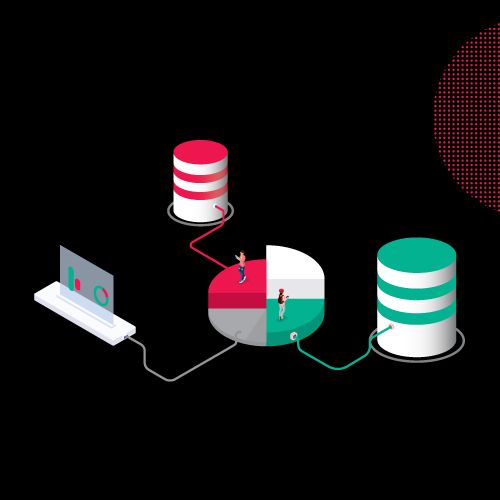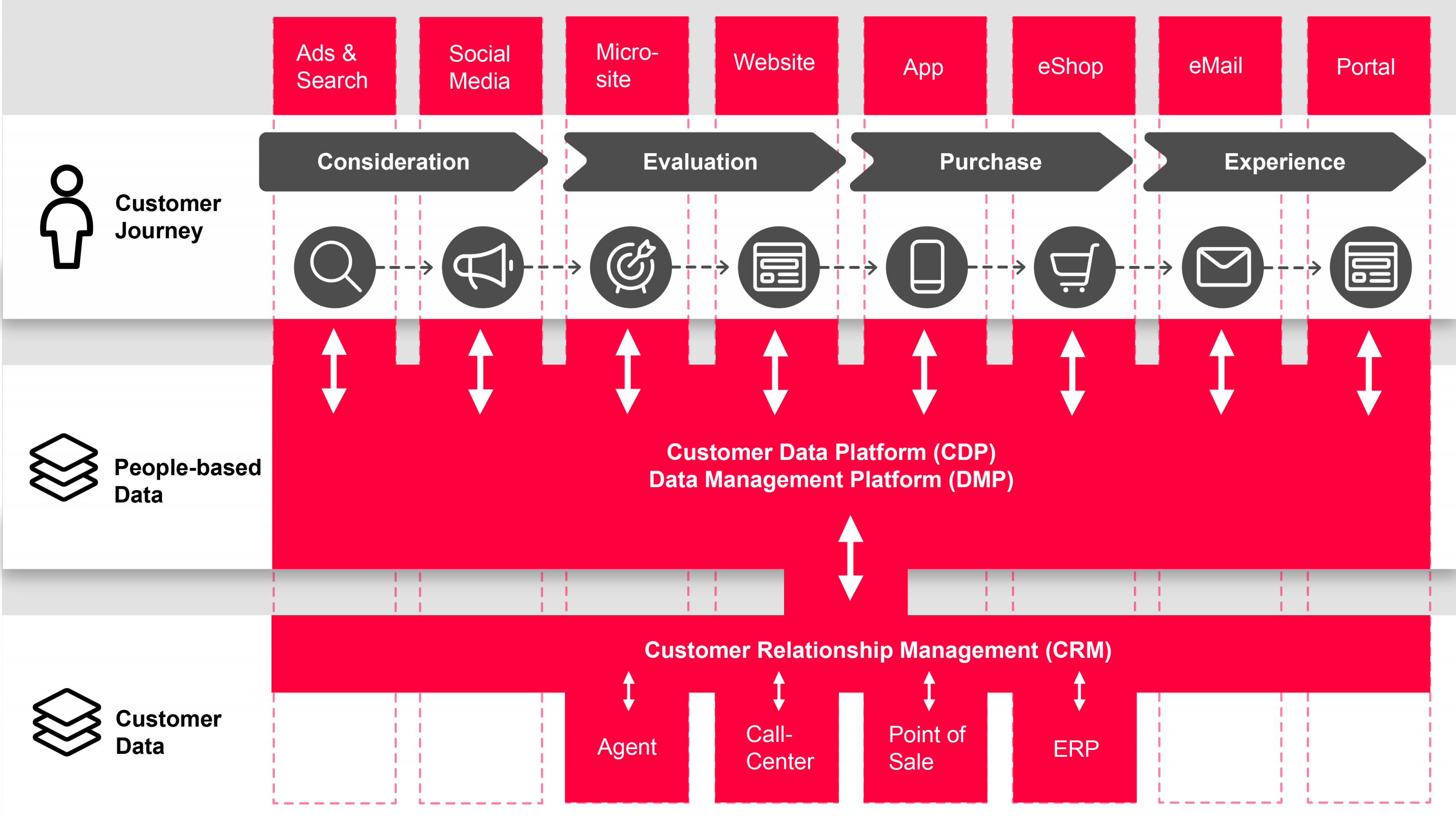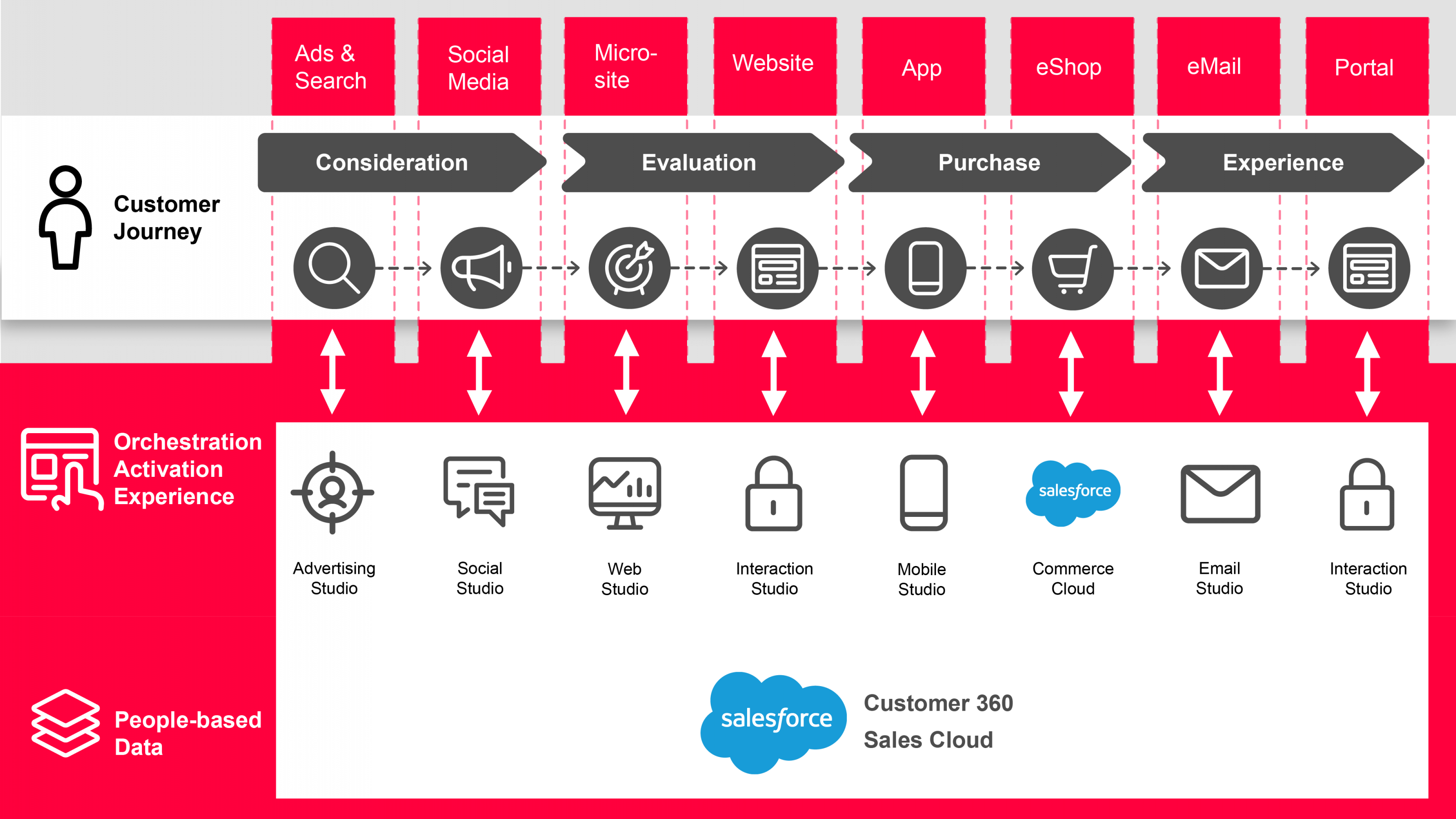Technology as the basis for People-based Data
Use the appropriate tools to bring data together optimally along the customer journey

Customer Data Platforms as a central data pool
If you want to gain an edge over the competition in media and marketing today, you need not only creativity, but above all tech and data competence. As the first part of this blog series has shown, merging digital data with people-based data is the decisive factor for success. For the technical solution to store and activate people-based data, Customer Data Platforms (CDPs) are the system of choice today. The product category of CDPs is still young and has grown from the need to make user profiles accessible for marketing purposes such as segmentation and activation. In the pre-CDP era, "marketing databases" often took over this task - databases with contacts, potential prospects and leads. Only after appropriate qualification by the sales department or even after a purchase was completed were these transferred to CRM. The marketing databases were mostly proprietary developments of companies, which could often be flexibly extended and adapted by the marketing department.
Due to the increasing complexity of marketing architectures and the multitude of marketing technology tools (MarTech for short) for the growing number of channels, these marketing databases are now receiving more attention in the architectures. Standard products have also developed in parallel to this trend. In principle, these CDP products are characterized by the fact that they take data streams from different channels, assign them at user level and finally make them accessible to third-party systems for further use or activation. Segmentation and analysis functions are also frequently included in the product scope.

Linking of different systems is crucial
Products related to CDPs are Data Management Platforms (DMPs). Historically, they have evolved from the advertising environment and have performed similar tasks for user profiles of programmatically delivered ads. However, since the advertising environment is mostly anonymous, cookie-based user profiles, DMPs do not normally have the ability to store people-based data. However, they still function as a supplement to CDPs in order to make users on third-party platforms accessible on a cookie-based basis. Due to the progressive restriction of cookies by browser manufacturers on the one hand and legal provisions such as the DSGVO on the other hand, DMPs based on 3rd party cookies will increasingly lose relevance. Analytics systems also collect behavioral data for the owned channels, usually in a more granular manner than DMPs or CDPs. These user profiles are usually created on an anonymous basis, so that analytics systems cannot replace CDPs, but complement them.
The transition from CDP to CRM is similarly fluid. The main difference is that a CRM system generally does not contain anonymous contacts, but CDPs can contain them. This is precisely the reason why a CRM system does not replace a CDP – because for many marketing activities such as advertising or content targeting, it is precisely the stored knowledge about anonymous contacts that is decisive. Nevertheless, the value of the people-based data is of course further enhanced when CRM data of known contacts is fed back to a CDP. In many cases, only integration enables the linking of customer-specific information collected during the entire purchase history including offline channels such as call centers or points of sale. In order to use the people-based data stored in CDPs for marketing activation, AdTech and MarTech tools such as e-mail automation systems, content targeting systems or Demand Side platforms (DSP) access them. These systems can use the data to achieve consistent personalization or display the Next Best Action in their respective channel. For example, a demand side platform can now display an ad for Scandinavia holidays to the user because the user has shown interest in it in a call center call, even if he originally clicked on the Tuscany ad. However, it is precisely such use cases in the advertising environment that are becoming more unreliable as cookie restrictions increase. Here again, the key to a solution lies in identified user profiles - on both the advertiser and publisher side.
Marketing Cloud Suites enable a holistic experience
Since a typical customer journey often spans many channels, a corresponding number of MarTech systems are involved in providing a cross-channel experience. In order to reduce the complexity of the interfaces involved, Marketing Cloud Suites have established themselves, with which a manufacturer provides all channel-specific activation tools as well as the continuous data layer for people-based data. Providers of such marketing clouds include Adobe, IBM, Oracle, SAP and Salesforce. In the Salesforce Marketing Cloud, the activation systems are called, for example, "Advertising Studio" for ads and search, "Social Studio" for social media, "E-Mail Studio" for e-mail nurtures or "Web Studio" for the creation of microsites and landing pages. At the data level, the "Contact Builder" and "Customer 360" are used to store and manage the people-based data elements. These are supplemented by the "Audience Studio", which can, for example, form segments for activation on the channels. The individual Salesforce tools are strongly interlocked with each other, so that a complex integration - as is the case with various individual tools - is not necessary or at least greatly reduced. One of the particular strengths of Salesforce is the synchronization of contacts in the Marketing Cloud with those in the CRM system or the Salesforce Sales Cloud.

The interaction of idea, creativity, tech and data brings marketing success
At the end of the day, a marketing cloud reduces the time-consuming integration work of the technical interfaces between the individual channel tools. Marketers have the possibility to create a consistent journey across different channels using only one interface. This is much more efficient than switching back and forth between different MarTech tools depending on the channel. A further advantage is the reuse of defined assets: images are loaded into the Marketing Cloud once and then reused only for the different channels in an optimized way. The realization of an idea for a seamless customer journey is thus in the hands of the marketer and not in those of the person responsible for data interfaces.
This closes the circle: because no successful campaign can be realized with Tech and Data alone. After all, successful digital marketing requires a harmonious interaction of idea, creativity, technology and data.
Five steps to the People-based Data Strategy
Would you like to get off to a good start with people-based data? Sometimes it is worth taking a step back and taking a look at the strategy. This forms the basis for your measures. For an optimal start, I will show you how to achieve a people-based data strategy in five steps.














